Even the savviest traveling diver might be bewildered by the wealth of diving options available in the Republic of Indonesia, the fourth most-populous country in the world. Situated between Malaysia and Papua New Guinea, the islands of Indonesia are spread out over 741,000 square miles of some of the most biodiverse and pristine marine environments on the planet. The country consists of 17,500 islands, 6,000 of which are more or less populated. With its multitude of sites and their unusual-sounding names, how does one choose between Wakatobi, Lembeh, Raja Ampat, Cenderawasi Bay, Alor, Ambon and Halmahera? Perhaps the best answer is to visit all these and more, but if you are looking for just one spot that rises to the top in terms of reasonable access and spectacular marine interactions, Komodo could be it.
A confluence of geographic factors conspires to make Komodo an underwater wonderland. The island straddles the boundary between two great bodies of water: the Pacific and Indian Oceans. Along Komodo’s west coast, the 11-mile-wide Sape Strait funnels water southward from the Flores Sea (part of the Pacific Ocean) into the Savu Sea (part of the Indian). The enormous volume of warmer and less saline Pacific water mixes with the Indian Ocean water to give rise to a stunning diversity of marine creatures and notable climatic variations throughout the region. This moving and mixing of water means tropical influences for the equatorial dive sites in the Flores Sea and temperate waters (and thus, different marine life) in the sites farther south. Continual replenishment of nutrients and larvae has created an environment that boasts more than 1,000 species of fish (including seven species of shark), 260 species of coral, 70 species of sponge and 16 species of marine mammal (including dugongs, whales and dolphins).
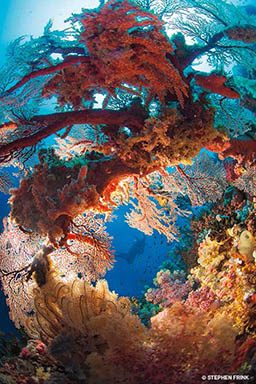
Diving In
The currents affect where and when the diving is best, and the diverse topography includes seamounts, shallow reefs and vertical walls. Briefings by a knowledgeable dive guide are very important here, and every diver should carry a surface marker buoy as well as an audible signaling device. The currents weren’t particularly extreme during our visit — to the extent that I wondered what all the “current” hoopla was about. However, I’m sure that where you dive, when you dive and under what lunar influence can each make a big difference. “Ripping current” is mentioned consistently enough in Komodo trip reports that I believe it must be true. Having a charter devoted to underwater photography (like ours) skewed the site selection away from current so heavy you couldn’t stop to take a picture. But there are pelagic creatures that go with the flow, which makes site selection tailored to the group a significant variable in Komodo diving.
Temperature can likewise vary from site to site. I typically dived with a 3mm suit and hooded vest and was never particularly cold. There were a few sites that were described as being typically cooler, and so I made the proactive choice to dive with a 5mm suit and hooded vest and was again quite comfortable. If I had to carry only one suit to Komodo it would probably be the 5mm, and I’d bring the hooded vest for layering as needed.
Komodo National Park
Komodo National Park was established in 1980 with the original intention of providing protection for Varanus komodoensis, the Komodo dragon. As awareness of the area’s extraordinary biodiversity dawned, the goals changed, and the vision for protection expanded. By 1986 the park was declared a World Heritage Site and a Man and Biosphere Reserve by the United Nations Educational, Scientific and Cultural Organization (UNESCO). Komodo National Park includes three major islands — Komodo, Rinca and Padar — and numerous smaller islands. The park’s biodiversity is best experienced by liveaboard boat.
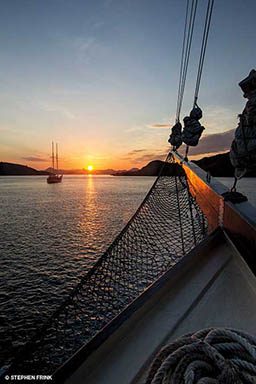
Most liveaboard tours begin in Labuhan Bajo and cruise leisurely in a counterclockwise direction. There are scores of liveaboards operating in Komodo, and the boats have something of a gentlemen’s agreement to try to hit the most iconic sites at different times to ensure an optimal underwater experience for their guests.
Sebayor Kecil
Unlike so much of the diving world, where sites are predictably called “Aquarium” or “Mermaid’s Garden,” most of the sites in Komodo have Indonesian names. My first underwater encounter of the trip was a pair of cuttlefish at Sebayor Kecil. I had just rolled over the side of the tender and cleared my mask when I chanced upon the pair. While they weren’t ever close enough together that I could get them in the same frame, it was fascinating to watch their dramatic color shifts as they floated amid shallow staghorn corals. Giant trevally surrounded large coral-encrusted boulders in waters with 80- to 90-foot visibility. Crocodilefish, bumphead parrotfish, a variety of nudibranchs (including both Chromodoris lochi and Chromodoris magnifica) and clouds of bluestriped fusiliers decorated the reef.
Tatawa Besar
This was an outstanding wide-angle experience. Iridescent blue water washed over large stands of orange soft coral, and the simple color contrast was breathtaking. This dive was so different from all the rest that I requested we revisit it later in the week. Opal sweepers are typically found here, swarming out of one particular reef crevice, and batfish compete with sweetlips for the attention of cleaner wrasses. This site made me appreciate how prolific sea turtles are in the region, which is no doubt due to the protection afforded by the national park status.
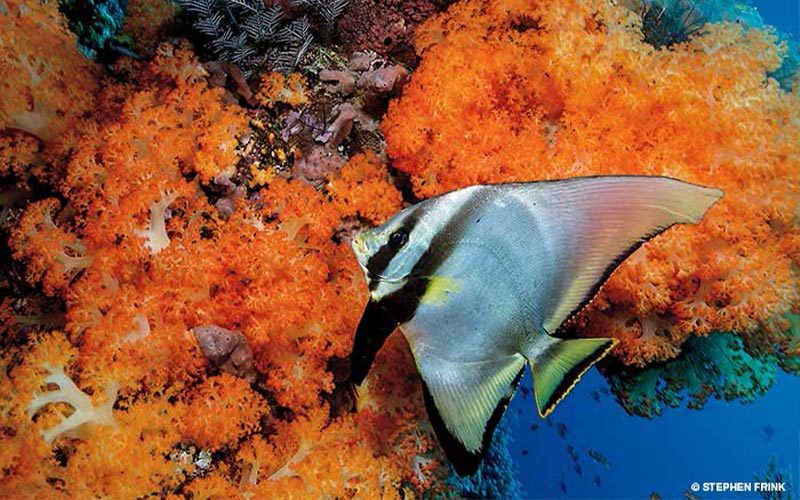
On a single pass with one turtle I shot more than 100 images. Now before I get a nasty letter from someone imagining I hogged the photo op, or worse yet stressed the turtle, be aware that I frequently looked around and found that, other than my dive guide, there was no one nearby. There was so much to shoot that nobody would have begrudged me my time with the turtle anyway. As for the turtle, it was so indifferent to my presence that it continued to forage the whole time. In fact, when it did finally seem to notice me I think it mistook my mini-dome for a jellyfish and swam in to take a bite. Finding it inedible (and fortunately scratch resistant), the turtle went back to rooting around amid the shallow corals. As the trip went on we all grew jaded to turtle encounters because there were so many that were so good. But this one, being the first of the trip, was the most exciting.
Castle Rock
This popular seamount off Gili Lawa Laut had significant current, but the abundance of colorful filter feeders provided ample motivation to swim a bit harder than usual and then tuck into whatever lee could be found. The visibility was excellent, but even the large emperor angelfish seemed reluctant to leave the shelter of the reef to fight the flow. As a result, the reef dwellers were easy to approach. While some in our group were content to clip off with reef hooks and watch the underwater world pass by, others performed an aerobic circumnavigation of the rock to find (no surprise) a hawksbill turtle and thousands of anthias amid shallow antler corals.
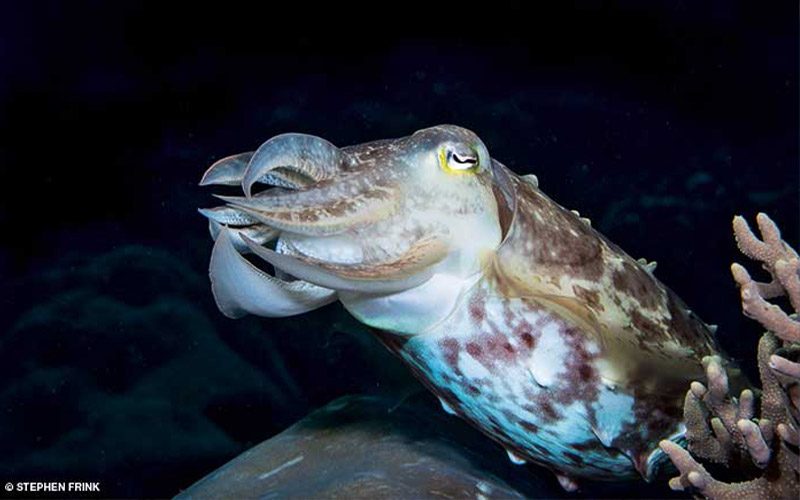
Lighthouse Reef
This is another site off Gili Lawa Laut that we chose to revisit later in the week for its stunning expanse of hard corals in only 15 feet of water. The reef slope was reasonably productive for fish and macro photography, but after a short excursion down to 60 feet I realized the best of it was in the shallows, where large table corals sat atop impossibly slender, soft-coral-festooned legs. Our return visit was the last dive of our trip. With the airplane lifting off the following day, this spot offered a nice way to enjoy a quality underwater experience while avoiding significant nitrogen loading.
Batu Moncho
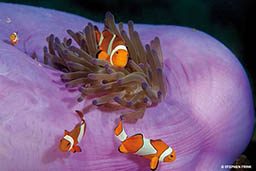
For a photographer, perception of a dive site has a lot to do with the lens mounted. I chose a 100mm macro for this dive and found a wealth of macro subjects, including signal gobies, Randall’s jawfish, juvenile harlequin sweetlips, mantis shrimp, pink squat lobsters and crinoid clingfish. But despite the myriad macro, my best shot of the dive was a clownfish in a gorgeous lavender anemone. Sheesh. Once again Nemo distracted me from so much else. Looking back at the divemaster’s report I see I missed “manta, black ribbon eels, commensal shrimp, reef cuttlefish, spiny lobster, fire gobies, peacock mantis shrimp and nudibranchs: Nembrotha kubaryana and Glossodoris cincta.” Fortunately, we caught a second dive at this site, and it proved to be a far more eclectic image-making experience for me, revealing, among other critters, the ever-elusive pygmy seahorse.
Gazer Beach
I’m not necessarily a huge fan of night dives because they tend to be so sporadically rewarding — well that and because they often come at the end of a long day of diving. They do offer opportunities to photograph things that can’t be shot in the daytime, but in many cases night dives are offered just because the boat is already at anchor for the night. Others are truly fascinating. Gazer Beach is in the latter category, even though it is only a sand slope — or, more correctly, because it’s a sand slope, one that’s home to bobtail squid, stonefish, Napoleon snake eels, flying gurnards, blue-spotted stingrays, peacock flounders and the marquee sand-dweller of them all, the stargazer.
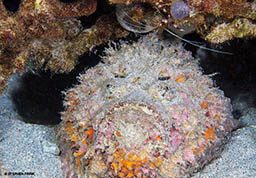
Floating above the slope at about 45 feet I see flashes going off to my right and left. We had been told in the briefing that this is where we would likely see stargazers, and my friends had already found theirs. I had the choice of waiting in line for my turn or continuing to search on my own. I was happy enough with this strategy as it rewarded me with a large stonefish at the base of a small bommie. Then no sooner had I abandoned it I noticed — nestled into the sand with only its eyes and mouth exposed, patiently, stealthily waiting for whatever hapless prey might come within snapping distance — my first stargazer of the night.
Gili Banta Bay
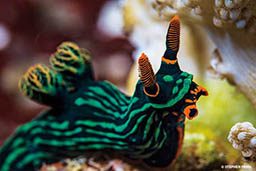
Similar to my experience with the cuttlefish on my first dive, dropping off the side of the boat here immediately revealed a very large crocodilefish perched atop a plate coral. It was totally unconcerned with how close I got, where I positioned my strobes and whether a dive model swam near it, and I spent the first 15 minutes of my dive working with it. Then seeing the reef so alive in the shallows I just swam laterally along the reef face, enraptured with the massive fields of staghorn coral. Having dived so many places in the world where staghorn was plentiful and then disappeared in the relative blink of an eye, I now gratefully stop to enjoy these hard coral gardens for the wonders they are. I dived this site first with a fisheye and then later with my 100mm macro lens. The macro lens gave me an entirely different perspective on Gili Banta, revealing Nembrotha milleri and Chromodoris magnifica nudibranchs as well as mushroom coral pipefish and porcelain crabs.
Rinca Island — Komodo Dragons
Several years ago National Geographic magazine did a feature called “The Man Who Wasn’t Darwin,” profiling naturalist, explorer and biologist Alfred Russel Wallace. In the article, the author noted:
Wallace arrived at Singapore in April 1854 and spent the next eight years zigzagging among the islands, traveling by every sort of boat, from mail steamer to merchant schooner to dugout canoe. Onshore, he lived as the local people lived, sheltering in thatched houses and eating whatever could be traded for or bought. He made stops on Sumatra, Java, Bali, Lombok, Borneo, Celebes, Gilolo, Ternate, Batchian, Timor, Ceram, a little cluster of islands called Aru at the eastern extremity of the archipelago, and the Vogelkop peninsula of New Guinea. He sailed close past the island of Komodo (but despite his search for notable fauna, remained unaware of the existence of Komodo dragons).
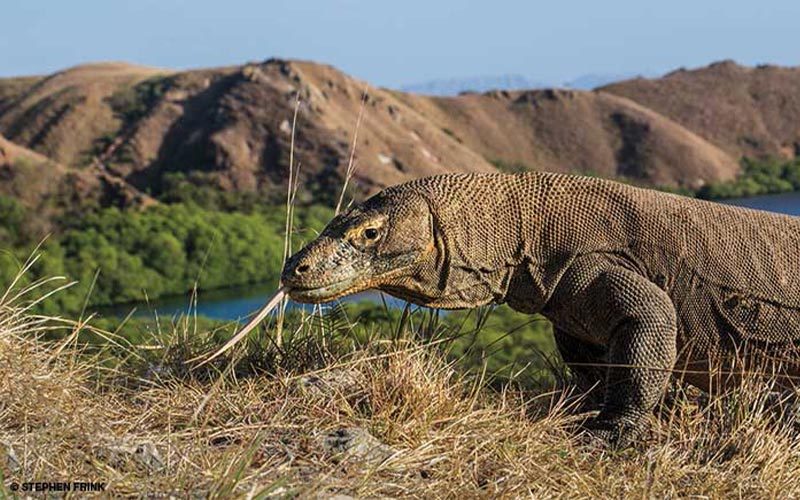
For a man whose life was spent chronicling biodiversity throughout the Malay Archipelago to have missed the Komodo dragon was astounding, and this left them virtually unknown for another half century. But perhaps this was just as well for Wallace — Komodo dragons are formidable predators, growing up to 10 feet long, weighing as much as 200 pounds, able to sweep a man off his feet with a flick of the tail, eviscerate him with razor claws or envenom him with a paralyzing protein concoction. Maybe it was better for Wallace to have missed Komodo dragons entirely than to have been surprised by one while at the campfire one night.
At Rinca Island our hike into the highlands was led by guides from Komodo National Park, each carrying a forked stick to fend off any dragon that might approach too close or too aggressively. Our walkabout revealed five dragons, which I thought was very fortunate. Then I figured out it was not luck; their sense of smell is excellent, and I believe they were hunting us. This was reinforced when I bent down to get an upward-angle photo of a stationary dragon, and it very quickly and aggressively approached. Now I was a perceptually smaller target, one its little brain and predator’s prerogative suggested it might easily conquer. If not for the quick intervention of our guide and his forked stick, I might have had a macro shot of a saliva-soaked maw just before it clamped down on a convenient appendage. The dragons’ attack strategy is a bit random; they don’t have to be precise, as the venom will take its toll no matter where the prey is bitten.
Cannibal Rock
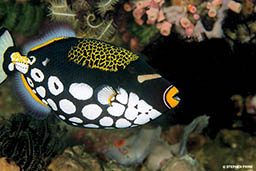
No discussion of Komodo diving is complete without a mention of Cannibal Rock, for it’s one of the most prolific and rewarding critter dives on the planet. That’s high praise I know, but for sheer quantity of marine life and abundance of soft corals and seafans for backgrounds, this place has to stand in the global top 10. From my dive diary at Cannibal Rock:
This is one of the world’s great dives. Solid walls of filter feeders. Sea apples, crinoids, soft corals, nudibranch, frogfish, schooling blue-lined snapper, turtle, coral grouper, butterflyfish, angelfish, anthias, tubastrea (orange and green varieties). Viz only 35 to 40 feet and green, and the water temperature dropped down to 75°F, but it hardly mattered because the life was so abundant and fearless I could get extraordinarily close. In the winter the conditions in the north and south swap, and you could have 120-foot viz here. That would be a sight to behold. All this marine life, all these filter feeders and clear water as well. Nirvana!
I could have done two days here, but we had to move on, for we had a date with mantas the next morning.
Manta Alley
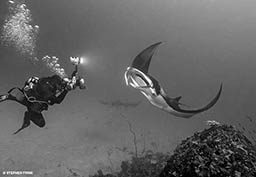
I was hoping Manta Alley wasn’t a site appellation like “Hammerhead Junction,” where someone saw something unusual once and stuck a name on it. Happily, this was the real deal — a site where cleaning stations attracted manta rays so reliably that the dive briefing was perfectly accurate about where we would encounter mantas. There is an underwater amphitheater at 80 feet where we were advised to remain motionless, tuck into the boulder-strewn reef face and wait for the mantas to close in. The trick here is to let the mantas come to you — breaking ranks and approaching the mantas tends to move the action deeper and farther from the cleaning stations. However, as the mantas made wide circles to return for more of their daily hygiene, close encounters were likely.
When our bottom time elapsed, we rose into the current and rounded a small island to the east. To our delight, we found ourselves among the mantas again. They swam back and forth in the channel, funneling plankton across their gill rakers, silhouetted overhead in the morning light.
How to Dive It
Getting there: From Bali you’ll fly to Labuan Bajo on the island of Flores or to Bima on the island of Sumbawa. Each has flights daily. Confirm your port of departure with your liveaboard.
Conditions: Water temperatures vary widely, from 86°F in the north to 65°F at some of the southern dive sites that may experience cold-water upwelling. It’s best to bring layers of thermal protection or even multiple wetsuits. Currents vary site to site. They may be high velocity or nonexistent. Travel with a surface marker buoy, preferably one that can be deployed from depth on a reel.
Hyperbaric chamber: There is no hyperbaric facility in Komodo; the nearest chambers are in Bali and Manado.
Travel documents: Your passport is valid for six months from your date of arrival (with proof of onward ticketing); there is a $25 (USD) charge for the visa. The departure tax is about $25, payable in rupiah.
Komodo National Park and port fee: $130, typically paid on board
Local currency and fees: Rupiah is the local currency. It is necessary to have some rupiah because departure taxes and overweight baggage charges must be paid in local currency. Each passenger is required to pay an airport tax at check in. The airport tax is 40,000 rupiah at Bali Domestic Airport, 200,000 rupiah at Bali International and 11,000 rupiah at Labuan Bajo.
© Alert Diver — Q1 Winter 2015